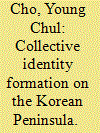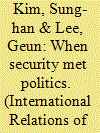|
|
|
Sort Order |
|
|
|
Items / Page
|
|
|
|
|
|
|
| Srl | Item |
| 1 |
ID:
093859


|
|
|
|
|
| Publication |
2010.
|
| Summary/Abstract |
Focusing on the US Clinton and Bush administration's dissimilar security policies and practices toward the Korean Peninsula, this article aims to examine how the two different external security environments shaped South Korea's collective identity in relation, respectively, to the United States and North Korea, and the Sunshine Policy in different ways, with a temporal focus on the Kim Dae-Jung administration (1998-2003). In so doing, this article will investigate the following substantive questions: what are the reason and implication of harmony between South Korea-US alliance identity and inter-Korean national identity in South Korea during the Clinton administration? In contrast, what are the reason and implication of discord between the two identities during the Bush administration? Related to these questions, this article presents two analytical arguments on the formation of South Korea's collective identity associated with the Sunshine Policy, along with an International Relations theoretical argument implicated in the empirical analysis.
|
|
|
|
|
|
|
|
|
|
|
|
|
|
|
|
| 2 |
ID:
193631


|
|
|
|
|
| Summary/Abstract |
This study uses leadership trait analysis to examine the link between personality and policy regarding South Korea’s Sunshine Policy toward North Korea and demonstrates that Kim Dae-jung’s personality characteristics largely accounted for this policy’s content, process, and outcome. With an analytical focus on the decision-making system, this study finds that Kim’s formal model was characterized by a control deemed inherently more indirect, subtle, and socialized than direct, personalized, or outright. Specifically, this type of control can be attributed to Kim’s personality traits, such as a persistently high need for power and relationship focus, along with other idiosyncratic style variables, such as disinclination toward interpersonal conflict, a sense of efficacy, and a sophisticated cognitive quality. President Kim’s resulting management style had the effect of empowering members of his advisory group and invigorating the policy process. In addition, the president’s trusted chief of staff, who served as a competent and thoughtful custodian manager with substantial authority, helped manage the system effectively and enhanced its stability. The study concludes that Kim Dae-jung’s management style, incorporating socialized control over decision-making, combined with his advocate leadership style in implementation (marked by a relentless push for his rapprochement agenda and a tendency to challenge constraints indirectly), helped accelerate the overall policy process. This contributed to the improvement of inter-Korean relations during his presidency.
|
|
|
|
|
|
|
|
|
|
|
|
|
|
|
|
| 3 |
ID:
183160


|
|
|
|
|
| Summary/Abstract |
How best to understand South Korea’s engagement policy towards North Korea? Has it been interpreted correctly and untainted by the current political cleavage between different ideological blocs? Given that Kim Dae-jung, the South Korean president from 1998 to 2003, is widely regarded as the archetype of the engagement policy, this analysis re-evaluates his approach by examining his presidential speeches where three concepts emerge from a critical discourse analysis: securitisation, globalisation, and humanisation. This analysis argues that when it comes to evaluating this engagement policy, these concepts need greater comprehensive consideration. This analysis not only shows the necessity of synchronic policy analysis, it also offers an opportunity to reflect diachronically on the ways in which Kim’s engagement discourse was later adopted by politicians across the political spectrum that deal with North Korea. This is important to consider because his discourse continues to shape the inter-Korean negotiation process.
|
|
|
|
|
|
|
|
|
|
|
|
|
|
|
|
| 4 |
ID:
101960


|
|
|
|
|
| Publication |
2011.
|
| Summary/Abstract |
This study delves into an empirical case analysis of the desecuritization process of the North Korean threat under the Kim Dae-jung government. Unlike previous studies, it analyzes how domestic and international actors desecuritized traditional threats by taking the pluralistic political processes of a democratic polity seriously. This was the process of competition between different political coalitions and the process of transformation from issues of high politics into issues of low politics. It remains to be seen whether the Kim Dae-jung government's desecuritization of North Korean threats was a deep or a shallow one, but it appears to be clear that the desecuritization of North Korean threats by the Kim Dae-jung government paved the way for another 5 years of progressive government with Roh Moo-hyun's 'unexpected' victory in the 2002 presidential election.
|
|
|
|
|
|
|
|
|
|
|
|
|
|
|
|
|
|
|
|
|